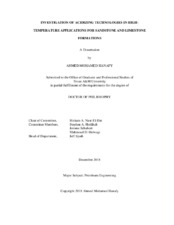| dc.description.abstract | Formation matrix acidizing is an essential step in the life of any oil or gas production well. The stimulation process is basically designed around the mineralogy of the formation, the goal of the treatment, the lithology, and the petrophysical properties. Due to their complicated mineralogy, sandstones are difficult formations when it comes to stimulation. Both the clay content and the clay type determines the success or the failure of any acidizing process. Calcite formations, however, are easier to acidize. The acidizing process aims to induce wormholes along the formation to enhance the overall productivity of the formation. Yet, the variation of the formation permeability, even between two adjacent low-permeability calcite veins, makes acid stimulation challenging. This work aims to investigate and refine the matrix acidizing process in high pressure high temperature environment for both sandstone and limestone formations.
The sandstone analysis was conducted through coreflood experiments on cores that were damaged by induction of fines migration using deionized water. Three formations were investigated in this study: Bandera, Grey Berea, and Kentucky sandstones. Each of the formations was stimulated in the presence of fines migration and then compared to the results of stimulating undamaged cores. All studies were conducted at 150 and 250˚F to assess the impact of the temperature. All cores were scanned using computed tomography (CT scan). A new technique was then developed to track the acidizing outcomes based on the CT scans. All cores were also scanned using nuclear magnetic resonance (NMR) to assess the variation of the petrophysical properties and to validate the data from the new CT scan analysis.
The limestone analysis in this study was based on single and dual coreflooding techniques. The experimental process was designed to investigate the viscoelastic surfactants at 150 and 250˚F in 15 wt% HCl and their compatibility with different corrosion inhibitors. The dual corefloods were assessed based on the extent of the wormhole propagation in the low-permeability cores. The rheological properties of the VES acid mixture was evaluated in the presence of acid additives such as corrosion inhibitors, emulsifiers, and iron control agents.
The acidizing of the different sandstone formations in the presence and the absence of fines migration showed a complex response with the variation of the clay mineral type and content. The new CT scan processing technique coupled with the NMR pore structure assessment succeeded in tracking the formation damage at each step of the study. In general, the formation damage from the secondary and tertiary reactions was maximized at 250˚F. Results show the mobilization of the fines to cause localized damage at the core outlets.
The examination of the VES system as a self-diverting acid system at 250˚F succeeded in increasing understanding and improving investigation of technology limitations. The cationic viscoelastic surfactant maintained a range of 200 to 800 cp at 250˚F. The apparent viscosity and the temperature range of the surfactant depended highly on the VES concentration and the chemistry and concentration of the additives. In addition, coreflood experiments showed the ability of the system to work at 150 and 250˚F. | en |


